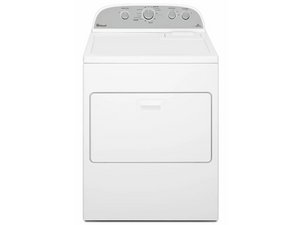Hi @fishtoasts ,
What is the model number of the dryer?
Most likely it will either be a faulty motor start capacitor (if it has one) or a faulty start winding in the motor. The motor's run winding is OK as the motor continues to run after the inertia of the motor in the stopped position has been overcome by you turning the motor manually.
Hi @fishtoasts ,
The short answer to the question in your comment is no.
You have to take the motor apart to see what the problem is and even then you may not be able to fix it. This is not a DIY motor repair. You need a motor rewind expert or a new motor. If you decide to replace the motor, the motor part number is 279827. Search online using the part number only to find suppliers that suit you best,.
For the long answer as to why, read on.
Firstly there is no capacitor in the motor circuit in your dryer as there is none showing in the parts list for the dryer.
Next, you can't measure the two motor windings with an Ohmmeter because they are connected in parallel connection. You would have to know the DC resistance of each winding to know whether you're measuring both windings or only the one and those values aren't written anywhere and I don't know them
A lot depends on how and where the windings are physically connected with each other and the centrifugal switch.
By that I mean both the windings i.e. run and start+switch) could be connected at the input terminal (possibly 4 wires). If this is the case you could separate the wires and check for continuity between each pair, but if one pair of wires tested open circuit i.e. start winding + switch, you still don't know if it is the start winding or the switch that is faulty. Also the centrifugal switch could be mounted on the outside of the windings or internally in the windings themselves.
If there are only two wires that come out from the windings connected on the back of the motor terminal block, then you're out of luck as the windings would have to be exposed and unwound to find where they're connected together and where the switch is.
Here's a image that shows how the windings are connected electrically and not physically and how they work.
(click on image to enlarge)
On the left is the start circuit. When voltage is first applied to the motor, current flows (green arrows) through both the main (run) and auxiliary (start) windings. This creates enough magnetism to make the motor start to rotate.
Once it gets up to speed, the centrifugal switch operates (due to centrifugal force) and disconnects the auxiliary winding (start) leaving the motor to run on the main winding only (red arrows)- see image on right side.
When the motor is stopped, the centrifugal switch releases and the start winding is placed back in circuit for the next time the motor has to start.
The reason is that it is more efficient and economical to operate the motor when it is wired this way.
Also, importantly, the wire used for the start winding is very thin and heats up quickly so you don't want it to be in circuit for too long as it may burn out. The wire used for the main winding is thicker and doesn't get so hot.
So the problem could be either a faulty start winding (burnt out) or a faulty centrifugal switch or even a faulty connection somewhere in the start winding circuit.
The humming is due to the motor trying to start on the main winding only and it can't produce enough magnetism to start to turn it from a stopped position i.e. can't overcome inertia, but once the motor is turning, it can keep it turning OK.
You said that it is easy to start it with little effort using your fingers, but don't forget that it is trying to turn a drum maybe full of heavy wet clothes which would take more of an effort to get it to start to turn and then to keep it turning than when there is no load on the motor at all



 11
11  367
367  1.4k
1.4k 
3 Comments
I have the same problem with my whirlpool dryer. How did you fix it? Is it a bad motor?
by B Y
@B Y
What is the model number of the dryer?
by jayeff
Whirlpool WGD5530SQ0. I'm pretty sure it's the motor. I already check tensioner, rollers, and belt.
by B Y